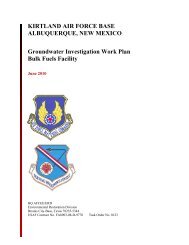Final FONSI and EA for hot cargo pad on Kirtland AFB - Kirtland Air ...
Final FONSI and EA for hot cargo pad on Kirtland AFB - Kirtland Air ...
Final FONSI and EA for hot cargo pad on Kirtland AFB - Kirtland Air ...
Create successful ePaper yourself
Turn your PDF publications into a flip-book with our unique Google optimized e-Paper software.
typically calls <str<strong>on</strong>g>for</str<strong>on</strong>g> restorati<strong>on</strong> of riparian areas as <strong>on</strong>e of the required management measures <str<strong>on</strong>g>for</str<strong>on</strong>g> achieving<br />
reducti<strong>on</strong>s in n<strong>on</strong>point source pollutant loadings.<br />
The USEPA issued a <str<strong>on</strong>g>Final</str<strong>on</strong>g> Rule <str<strong>on</strong>g>for</str<strong>on</strong>g> the CWA c<strong>on</strong>cerning technology-based Effluent Limitati<strong>on</strong>s<br />
Guidelines <str<strong>on</strong>g>and</str<strong>on</strong>g> New Source Per<str<strong>on</strong>g>for</str<strong>on</strong>g>mance St<str<strong>on</strong>g>and</str<strong>on</strong>g>ards <str<strong>on</strong>g>for</str<strong>on</strong>g> the C<strong>on</strong>structi<strong>on</strong> <str<strong>on</strong>g>and</str<strong>on</strong>g> Development point source<br />
category. All NPDES storm water permits issued by the USEPA or states must incorporate requirements<br />
established in the <str<strong>on</strong>g>Final</str<strong>on</strong>g> Rule. As of February 1, 2010 all new c<strong>on</strong>structi<strong>on</strong> (or demoliti<strong>on</strong>) sites that<br />
disturb 1 acre or more of l<str<strong>on</strong>g>and</str<strong>on</strong>g> are required to meet the n<strong>on</strong>-numeric effluent limitati<strong>on</strong>s <str<strong>on</strong>g>and</str<strong>on</strong>g> design,<br />
install, <str<strong>on</strong>g>and</str<strong>on</strong>g> maintain effective erosi<strong>on</strong> <str<strong>on</strong>g>and</str<strong>on</strong>g> sedimentati<strong>on</strong> c<strong>on</strong>trols, which include:<br />
<br />
<br />
<br />
<br />
<br />
<br />
<br />
<br />
C<strong>on</strong>trol storm water volume <str<strong>on</strong>g>and</str<strong>on</strong>g> velocity to minimize erosi<strong>on</strong><br />
C<strong>on</strong>trol storm water discharges including both peak flow rates <str<strong>on</strong>g>and</str<strong>on</strong>g> total storm water volume<br />
Minimize the amount of soil exposed during c<strong>on</strong>structi<strong>on</strong> activities<br />
Minimize the disturbance of steep slopes<br />
Minimize sediment discharges from the site using c<strong>on</strong>trols that address factors such as the<br />
amount, frequency, intensity <str<strong>on</strong>g>and</str<strong>on</strong>g> durati<strong>on</strong> of precipitati<strong>on</strong>, the nature of resulting storm water<br />
runoff, <str<strong>on</strong>g>and</str<strong>on</strong>g> soil characteristics, including the range of soil particle sizes expected to be present <strong>on</strong><br />
the site<br />
Provide <str<strong>on</strong>g>and</str<strong>on</strong>g> maintain natural buffers around surface waters, direct storm water to vegetated areas<br />
to increase sediment removal <str<strong>on</strong>g>and</str<strong>on</strong>g> maximize storm water infiltrati<strong>on</strong> where feasible<br />
Minimize erosi<strong>on</strong> at outlets <str<strong>on</strong>g>and</str<strong>on</strong>g> downstream channel <str<strong>on</strong>g>and</str<strong>on</strong>g> stream bank erosi<strong>on</strong><br />
Minimize soil compacti<strong>on</strong> <str<strong>on</strong>g>and</str<strong>on</strong>g> preserve topsoil where feasible.<br />
In additi<strong>on</strong>, c<strong>on</strong>structi<strong>on</strong> site owners <str<strong>on</strong>g>and</str<strong>on</strong>g> operators that disturb <strong>on</strong>e or more acres of l<str<strong>on</strong>g>and</str<strong>on</strong>g> are required to<br />
use BMPs to ensure that soil disturbed during c<strong>on</strong>structi<strong>on</strong> activities does not pollute nearby water bodies.<br />
Under the <str<strong>on</strong>g>Final</str<strong>on</strong>g> Rule <str<strong>on</strong>g>for</str<strong>on</strong>g> the CWA, USEPA is promulgating a series of n<strong>on</strong>-numeric effluent limitati<strong>on</strong>s,<br />
as well as a numeric effluent limitati<strong>on</strong> <str<strong>on</strong>g>for</str<strong>on</strong>g> the pollutant turbidity. USEPA is phasing in the numeric<br />
effluent limitati<strong>on</strong> over 4 years to allow permitting authorities adequate time to develop m<strong>on</strong>itoring<br />
requirements <str<strong>on</strong>g>and</str<strong>on</strong>g> to allow the regulated community time to prepare <str<strong>on</strong>g>for</str<strong>on</strong>g> compliance with the numeric<br />
effluent limitati<strong>on</strong>. Effective August 1, 2011, c<strong>on</strong>structi<strong>on</strong> activities disturbing a total of 20 or more acres<br />
at <strong>on</strong>e time, including n<strong>on</strong>-c<strong>on</strong>tiguous l<str<strong>on</strong>g>and</str<strong>on</strong>g> disturbances that take place at the same time <str<strong>on</strong>g>and</str<strong>on</strong>g> are part of a<br />
larger comm<strong>on</strong> plan of development, must comply with the numeric effluent limitati<strong>on</strong> <str<strong>on</strong>g>for</str<strong>on</strong>g> turbidity in<br />
additi<strong>on</strong> to the n<strong>on</strong>-numeric effluent limitati<strong>on</strong>s. The maximum daily turbidity limitati<strong>on</strong> will be 280<br />
nephelometric turbidity units. On February 2, 2014, c<strong>on</strong>structi<strong>on</strong> site owners <str<strong>on</strong>g>and</str<strong>on</strong>g> operators that disturb<br />
10 or more acres of l<str<strong>on</strong>g>and</str<strong>on</strong>g> at <strong>on</strong>e time are required to m<strong>on</strong>itor discharges from the site <str<strong>on</strong>g>and</str<strong>on</strong>g> comply with the<br />
numeric effluent limitati<strong>on</strong>. The USEPA’s limitati<strong>on</strong>s are based <strong>on</strong> its assessment of what specific<br />
technologies can reliably achieve. Permittees can select management practices or technologies that are<br />
best suited <str<strong>on</strong>g>for</str<strong>on</strong>g> site-specific c<strong>on</strong>diti<strong>on</strong>s.<br />
Secti<strong>on</strong> 438 of the Energy Independence <str<strong>on</strong>g>and</str<strong>on</strong>g> Security Act (EISA) (42 U.S.C. Secti<strong>on</strong> 17094) establishes<br />
into law new storm water design requirements <str<strong>on</strong>g>for</str<strong>on</strong>g> Federal c<strong>on</strong>structi<strong>on</strong> projects that disturb a footprint<br />
greater than 5,000 square-feet of l<str<strong>on</strong>g>and</str<strong>on</strong>g>. EISA Secti<strong>on</strong> 438 requirements are independent of storm water<br />
requirements under the CWA. The project footprint c<strong>on</strong>sists of all horiz<strong>on</strong>tal hard surfaces <str<strong>on</strong>g>and</str<strong>on</strong>g> disturbed<br />
areas associated with the project development. Under these requirements, predevelopment site hydrology<br />
must be maintained or restored to the maximum extent technically feasible with respect to temperature,<br />
rate, volume, <str<strong>on</strong>g>and</str<strong>on</strong>g> durati<strong>on</strong> of flow. Predevelopment hydrology shall be modeled or calculated using<br />
A-4
















